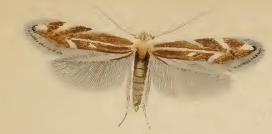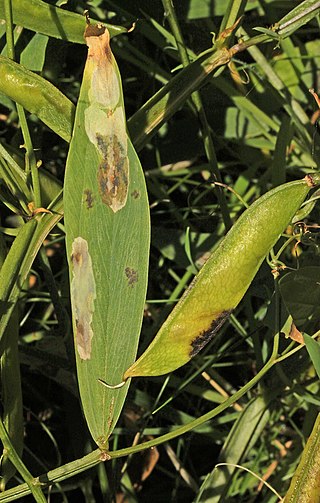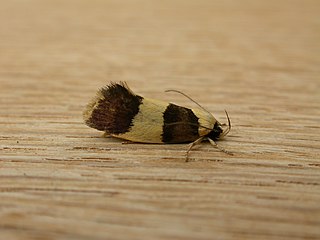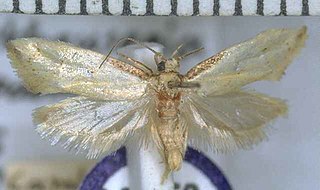
Carcina quercana is a species of moth of the family Depressariidae. It is found in Europe. It has been introduced recently in North America, British Columbia and western Washington. It is occasionally known by several common names including oak lantern, long-horned flat-body, and oak-skeletonizer moth.

Parornix anglicella is a moth of the family Gracillariidae found in Asia and Europe. It was described in 1850, by the English entomologist Henry Tibbats Stainton, from a specimen from Lewisham, Kent.

Stigmella glutinosae is a moth of the family Nepticulidae. It is found in all of Europe.
Xyroptila peltastes is a moth of the family Pterophoridae. It is found in Australia.

Bucculatrix maritima is a species of moth of the family Bucculatricidae. It is found in most of Europe, Russia and Japan. It was first described in 1851 by Henry Tibbats Stainton.

Leucoptera lathyrifoliella is a moth in the Lyonetiidae family. It is found in Finland, Germany and England.
Leucoptera lotella is a moth in the Lyonetiidae family. It is found from Denmark to Portugal, Italy and Croatia, and from Great Britain to Poland and Hungary.
Acrocercops lophonota is a moth of the family Gracillariidae. It is known from Java, Indonesia.

Telecrates laetiorella is a moth of the family Xyloryctidae. It is known from the Australian Capital Territory, New South Wales, Queensland, South Australia and Victoria.

Hellinsia tinctus is a moth of the family Pterophoridae. It is found in Arizona and Mexico.
Hypatima cirrhospila is a moth in the family Gelechiidae. It was described by Edward Meyrick in 1920. It is found in Assam, India.
Photodotis prochalina is a moth of the family Gelechiidae. It was described by Edward Meyrick in 1911. It is found in South Africa.
Stenoma recondita is a species of moth of the family Depressariidae. It is found in Guyana.
Antaeotricha modulata is a species of moth of the family Depressariidae. It is found in Brazil, Guyana and French Guiana.
Stenoma iatma is a moth of the family Depressariidae. It is found in French Guiana.
Deltoplastis byssina is a moth in the family Lecithoceridae. It was described by Edward Meyrick in 1910. It is found in Sri Lanka.
Aeolanthes ampelurga is a moth in the family Depressariidae. It was described by Edward Meyrick in 1925. It is found in northern India (Kumaon).
Imma grammarcha is a moth in the family Immidae. It was described by Edward Meyrick in 1905. It is found in Sri Lanka and possibly on Borneo.

Tingena apanthes is a species of moth in the family Oecophoridae. It is endemic to New Zealand and found on the North Island. The adults are on the wing from October to December. It appears associated with Leptospermum species and it has been hypothesised that the appearance of the adults of this species imitates faded Leptospermum leaves.
Antipterna acrobaphes is a species of moth in the family Oecophoridae, first described by Edward Meyrick in 1885 as Ocystola acrobaphes. The holotype was collected in Sydney, New South Wales, in January 1878.







